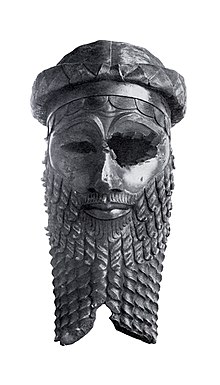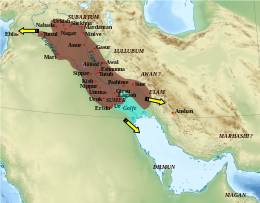Sargon Mkuu
Mandhari
| Sargon wa Akkad Šarru-ukīn | |
|---|---|
| Mfalme wa Dola la Akadi, Kish na Sumeri[1] | |
 | |
| Sanamu ya shaba ya kichwa cha mtawala wa Akadi, anayeweza kuwa Sargon au mjukuu wake Naram-Sin.[2] | |
| Tarehe za utawala | 2334–2284 KK hivi (MC)[3] |
| Baba | La'ibum |
Sargon Mkuu (kwa Kiakadi: Šarru-ukīn au Šarru-kēn, anayejulikana pia kama Sargon wa Akkad)[4] alikuwa mtawala wa kwanza wa Dola la Akad, maarufu kwa kuteka miji-dola ya Wasumeri katika karne ya 24 - 23 KK.[3]
Nasaba yake ilitawala miaka 100 hivi baada ya kifo chake.[5]
Inadhaniwa kuwa dola lake lilienea katika Mesopotamia na hata nje yake kutoka mji wa Akkad (pia: Agade).

Tanbihi
[hariri | hariri chanzo]- ↑ "King of Akkad, Kish, and Sumer" is a translation of the Akkadian phrase "LUGAL Ag-ga-dèKI, LUGAL KIŠ, LUGAL KALAM.MAKI". See Peter Panitschek, Lugal - šarru - βασιλεύς: Formen der Monarchie im Alten Vorderasien von der Uruk-Zeik bis zum Hellenismus (2008), p. 138. KALAM.MA, meaning "land, country", is the old Sumerian name of the cultivated part of Mesopotamia (Sumer). See Esther Flückiger-Hawker, Urnamma of Ur in Sumerian Literary Tradition (1999), p. 138.
- ↑ M. E. L. Mallowan, "The Bronze Head of the Akkadian Period from Nineveh", Iraq Vol. 3, No. 1 (1936), 104–110.
- ↑ 3.0 3.1 The date of the reign of Sargon is highly uncertain, depending entirely on the (conflicting) regnal years given in the various copies of the Sumerian King List, specifically the uncertain duration of the Gutian dynasty. The added regnal years of the Sargonic and the Gutian dynasties have to be subtracted from the accession of Ur-Nammu of the Third Dynasty of Ur, which is variously dated to either 2047 BC (Short Chronology) or 2112 BC (Middle Chronology). An accession date of Sargon of 2334 BC assumes: (1) a Sargonic dynasty of 180 years (fall of Akkad 2154 BC), (2) a Gutian interregnum of 42 years and (3) the Middle Chronology accession year of Ur-Nammu (2112 BC).
- ↑ also "Sargon the Elder", and in older literature Shargani-shar-ali and Shargina-Sharrukin. Gaston Maspero (ed. A. H. Sayce, trans. M. L. McClure), History of Egypt, Chaldea, Syria, Babylonia and Assyria (1906?), p. 90.
- ↑ Van de Mieroop, Marc. A History of the Ancient Near East: ca. 3000–323 BC. Blackwell, 2006, ISBN 978-1-4051-4911-2. p. 63.
Marejeo
[hariri | hariri chanzo]- Albright, W. F., A Babylonian Geographical Treatise on Sargon of Akkad's Empire, Journal of the American Oriental Society (1925).
- Bachvarova, Mary R., "Sargon the Great: from history to myth", chapter 8 in: From Hittite to Homer: The Anatolian Background of Ancient Greek Epic' , Cambridge University Press (2016), 166–198.
- Beaulieu, Paul-Alain, et al. A Companion to the Ancient near East. Blackwell, 2005.
- Botsforth, George W., ed. "The Reign of Sargon". A Source-Book of Ancient History. New York: Macmillan, 1912.
- Cooper, Jerrold S. and Wolfgang Heimpel. "The Sumerian Sargon Legend." Journal of the American Oriental Society, Vol. 103, No. 1, (January-March 1983).
- Foster, Benjamin R., The Age of Akkad. Inventing Empire in Ancient Mesopotamia, Routledge, 2016.
- Frayne, Douglas R. "Sargonic and Gutian Period." The Royal Inscriptions of Mesopotamia, Vol. 2. University of Toronto Press, 1993.
- Gadd, C.J. "The Dynasty of Agade and the Gutian Invasion." Cambridge Ancient History, rev. ed., vol. 1, ch. 19. Cambridge Univ. Press, 1963.
- Glassner, Jean-Jacques. Mesopotamian Chronicles, Atlanta, 2004.
- Grayson, Albert Kirk. Assyrian and Babylonian Chronicles. J. J. Augustin, 1975; Eisenbrauns, 2000.
- Jacobsen, Thorkild, The Sumerian King List, Assyriological Studies, No. 11, Chicago: Oriental Institute, 1939.
- King, L. W., Chronicles Concerning Early Babylonian Kings, II, London, 1907, pp. 87–96.
- Kramer, S. Noah. The Sumerians: Their History, Culture and Character, Chicago, 1963.
- Kramer, S. Noah. History Begins at Sumer: Thirty-Nine "Firsts" in Recorded History. Univ. of Pennsylvania Press, 1981.
- Lewis, Brian. The Sargon Legend: A Study of the Akkadian Text and the Tale of the Hero Who Was Exposed at Birth. American Schools of Oriental Research Dissertation Series, No. 4. Cambridge, MA: American Schools of Oriental Research, 1984.
- Luckenbill, D. D., On the Opening Lines of the Legend of Sargon, The American Journal of Semitic Languages and Literatures (1917).
- Postgate, Nicholas. Early Mesopotamia: Society and Economy at the Dawn of History. Routledge, 1994.
- Roux, G. Ancient Iraq, London, 1980.
- Sallaberger, Walther; Westenholz, Aage (1999), Mesopotamien. Akkade-Zeit und Ur III-Zeit, Orbis Biblicus et Orientalis, juz. la 160/3, Göttingen: Vandenhoeck & Ruprecht, ISBN 3-525-53325-X
- Schomp, Virginia. Ancient Mesopotamia. Franklin Watts, 2005. ISBN 0-531-16741-0
- Van de Mieroop, Marc. A History of the Ancient Near East: ca. 3000–323 BC. Blackwell, 2006, ISBN 978-1-4051-4911-2.
- Van de Mieroop, Marc., Cuneiform Texts and the Writing of History, Routledge, 1999.
Viungo vya nje
[hariri | hariri chanzo]| Makala hii kuhusu mwanasiasa fulani bado ni mbegu. Je, unajua kitu kuhusu Sargon Mkuu kama wasifu wake, habari za maisha au kazi yake? Labda unaona habari katika Wikipedia ya Kiingereza au lugha nyingine zinazofaa kutafsiriwa? Basi unaweza kuisaidia Wikipedia kwa kuihariri na kuongeza habari. |

